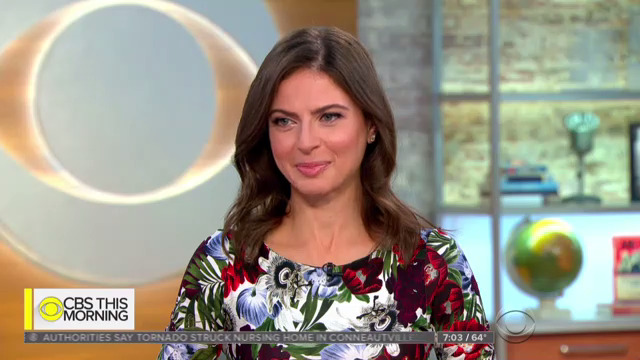For TV’s Morning Shows, Juggling Anchors Is Part of the Act
By Brian Steinberg
LOS ANGELES (Variety.com) – Bianna Golodryga has filled in at the desk of “CBS This Morning” so many times in recent months that when she recently woke up and saw the show on TV, she feared she had overslept. “Had I slept in?” she asked. “It has felt so natural to be there.”
No more questions about alarm-clock settings. Golodryga (pictured, above) was named the show’s fourth co-anchor this week – just the latest in a recent parade of tweaks to the nation’s big morning programs. Once a place where the same hosts would greet viewers each day ad infinitum –Joan Lunden held forth on ABC’s “Good Morning America” for 17 years – A.M. news shows in this era make changes nearly every few months.
At a time when consumers are just as happy to reach for their smartphone for news as they are for the TV remote, the shows can’t afford to stand pat . Even the recent Trump news cycle isn’t as reliable a crowd-gatherer at it once was, says Brian Hughes, executive vice president of audience intelligence and strategy at Magna, the Interpublic Group-owned media-buying firm. “We definitely saw a big surge” at morning shows following the elections, he says. “But people are a little bit too inundated at this point and that viewer interest has kind of died down.”
The average audience for morning news programs from ABC, CBS and NBC fell 10% in 2017, according to data from Pew Research Center, slipping to 3.32 million from nearly 3.7 million in 2016. In the economics of the industry, “Today” is TV’s A.M. leader, maintaining its lead among viewers between 25 and 54 – the demographic most coveted by advertisers in news programs.
Viewership at all three – “,” “” and NBC’s “” – also slipped in the past TV season, according to data from Nielsen. Overall viewership at “Today” fell 3% in the 2017-2018 TV season, which just ended last month, while dipping 6% at “Good Morning America” and 7% at “CBS This Morning.” Cable-news morning programs, says Hughes, garner smaller audiences, but tend to keep them on hand.
Blaming the phenomenon on any particular show is difficult. They all continue to do what they’re supposed to do. Savannah Guthrie and Hoda Kotb pressed forward in the wake of the ouster of Matt Lauer at NBC last year and have bolstered the program’s image . “CBS This Morning” regularly burnishes its hard-news credentials, with Gayle King, Norah O’Donnell and John Dickerson working to score newsmaker interviews. Producers at “GMA” have proven most willing to experiment, bringing a live audience to the show’s second hour and pairing Robin Roberts and George Stephanpoulos with a non-traditional host, the popular sportscaster Michael Strahan.
But the anchors are battling what seems like an unstoppable cultural shift. In August of 2017, Pew found 43% of Americans report often getting news online, just 7 percentage points lower than the 50% who often get news on television, according to a Pew Research Center survey conducted in August. In 2016, the gap between the two was 19 percentage points – more than twice as wide.
One solution is to keep the programs fresh. Golodryga adds another solid host to chase after in-depth stories, says Ryan Kadro, executive producer at “CBS This Morning.” “We want to do more of that type of programming,” he says. “We are looking for ways to put our people in positions to do what they do best, because it’s a value proposition.”
The positioning has turned “CTM” into something of a success story for CBS, which hasn’t had much of anything in the way of a morning mainstay since “Captain Kangaroo.” Its audience is at a relative high mark compared to the years before this show launched.
“Today” recently formalized a role that has been held by Craig Melvin, who had been the show’s weekend anchor. Melvin has for some time had a role during weekday “Today,” but now his appearances there may have more impact. The anchor has in recent months gained new presence thanks to his interview with former President Bill Clinton about whether he would have acted differently during the Monica Lewinsky scandal. Guthrie and Kotb remain the program’s co-anchors.
There is even some change on cable, where Chris Cuomo recently left CNN’s “New Day” to lead his own primetime show on the AT&T-owned network. Alisyn Camerota, who has developed a reputation for no-nonsense interviewing, has been joined by John Berman.
But no show has reworked itself as thoroughly as ABC’s “Good Morning America.” The program bears only a passing resemblance to how it looked in April of 2012, when it surpassed its NBC rival as the nation’s most-watched morning program. Josh Elliott and Sam Champion, part of the winning “GMA” team at the time, have moved on. Strahan was still working with Kelly RIpa on ABC’s syndicated “Live”at the time. These days, ABC is trying to take the energy of the second hour of “Good Morning America,” and import it to early afternoon , where Strahan co-hosts “GMA Day” with Sara Haines.
Playing up a broader team dynamic reverses a recent morning-show trend. In recent years, the shows have streamlined their opening half hours. NBC bid farewell to a formal “news reader” in May of 2016 when Natalie Morales decamped to “Access Hollywood.” “GMA” once boasted an on-air team akin to “The Avengers,” opening shows will everyone at once. These days, the program focuses on the troika of Roberts, Stephanopoulos and Strahan.
Expect more on-the-fly tweaks in the early hours of the day as TV tries to face down the digital exodius of its regular viewing base. “In the world we live in now, it’s going to get very hard to get to the point of where it’s growing again,” says Magna’s Hughes. “At this point, I think [viewership] stability Is the best you can hope for.”

